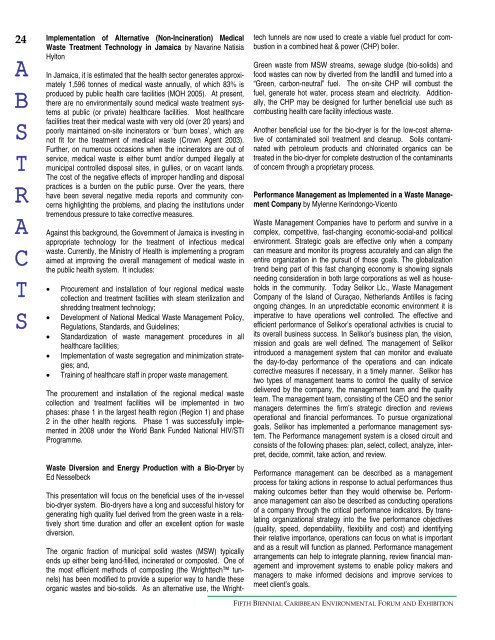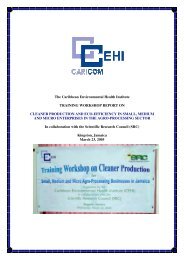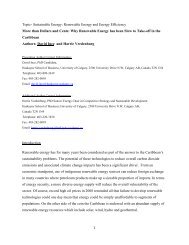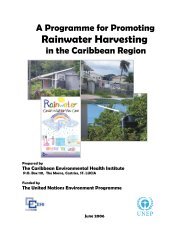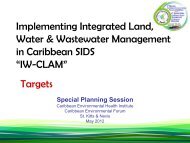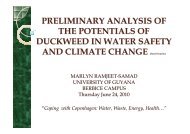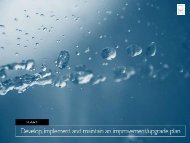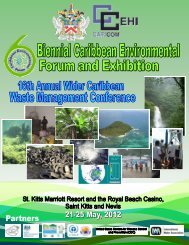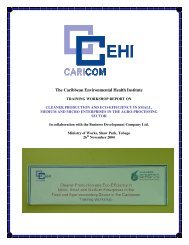conference magazine - Caribbean Environmental Health Institute
conference magazine - Caribbean Environmental Health Institute
conference magazine - Caribbean Environmental Health Institute
Create successful ePaper yourself
Turn your PDF publications into a flip-book with our unique Google optimized e-Paper software.
24 Implementation of Alternative (Non-Incineration) Medical<br />
Waste Treatment Technology in Jamaica by Navarine Natisia<br />
Hylton<br />
A<br />
B<br />
S<br />
T<br />
R<br />
A<br />
C<br />
T<br />
S<br />
In Jamaica, it is estimated that the health sector generates approximately<br />
1,596 tonnes of medical waste annually, of which 83% is<br />
produced by public health care facilities (MOH 2005). At present,<br />
there are no environmentally sound medical waste treatment systems<br />
at public (or private) healthcare facilities. Most healthcare<br />
facilities treat their medical waste with very old (over 20 years) and<br />
poorly maintained on-site incinerators or ‘burn boxes’, which are<br />
not fit for the treatment of medical waste (Crown Agent 2003).<br />
Further, on numerous occasions when the incinerators are out of<br />
service, medical waste is either burnt and/or dumped illegally at<br />
municipal controlled disposal sites, in gullies, or on vacant lands.<br />
The cost of the negative effects of improper handling and disposal<br />
practices is a burden on the public purse. Over the years, there<br />
have been several negative media reports and community concerns<br />
highlighting the problems, and placing the institutions under<br />
tremendous pressure to take corrective measures.<br />
Against this background, the Government of Jamaica is investing in<br />
appropriate technology for the treatment of infectious medical<br />
waste. Currently, the Ministry of <strong>Health</strong> is implementing a program<br />
aimed at improving the overall management of medical waste in<br />
the public health system. It includes:<br />
• Procurement and installation of four regional medical waste<br />
collection and treatment facilities with steam sterilization and<br />
shredding treatment technology;<br />
• Development of National Medical Waste Management Policy,<br />
Regulations, Standards, and Guidelines;<br />
• Standardization of waste management procedures in all<br />
healthcare facilities;<br />
• Implementation of waste segregation and minimization strategies;<br />
and,<br />
• Training of healthcare staff in proper waste management.<br />
The procurement and installation of the regional medical waste<br />
collection and treatment facilities will be implemented in two<br />
phases: phase 1 in the largest health region (Region 1) and phase<br />
2 in the other health regions. Phase 1 was successfully implemented<br />
in 2008 under the World Bank Funded National HIV/STI<br />
Programme.<br />
Waste Diversion and Energy Production with a Bio-Dryer by<br />
Ed Nesselbeck<br />
This presentation will focus on the beneficial uses of the in-vessel<br />
bio-dryer system. Bio-dryers have a long and successful history for<br />
generating high quality fuel derived from the green waste in a relatively<br />
short time duration and offer an excellent option for waste<br />
diversion.<br />
The organic fraction of municipal solid wastes (MSW) typically<br />
ends up either being land-filled, incinerated or composted. One of<br />
the most efficient methods of composting (the Wrighttech tunnels)<br />
has been modified to provide a superior way to handle these<br />
organic wastes and bio-solids. As an alternative use, the Wrighttech<br />
tunnels are now used to create a viable fuel product for combustion<br />
in a combined heat & power (CHP) boiler.<br />
Green waste from MSW streams, sewage sludge (bio-solids) and<br />
food wastes can now by diverted from the landfill and turned into a<br />
“Green, carbon-neutral” fuel. The on-site CHP will combust the<br />
fuel, generate hot water, process steam and electricity. Additionally,<br />
the CHP may be designed for further beneficial use such as<br />
combusting health care facility infectious waste.<br />
Another beneficial use for the bio-dryer is for the low-cost alternative<br />
of contaminated soil treatment and cleanup. Soils contaminated<br />
with petroleum products and chlorinated organics can be<br />
treated in the bio-dryer for complete destruction of the contaminants<br />
of concern through a proprietary process.<br />
Performance Management as Implemented in a Waste Management<br />
Company by Mylenne Kerindongo-Vicento<br />
Waste Management Companies have to perform and survive in a<br />
complex, competitive, fast-changing economic-social-and political<br />
environment. Strategic goals are effective only when a company<br />
can measure and monitor its progress accurately and can align the<br />
entire organization in the pursuit of those goals. The globalization<br />
trend being part of this fast changing economy is showing signals<br />
needing consideration in both large corporations as well as households<br />
in the community. Today Selikor Llc., Waste Management<br />
Company of the Island of Curaçao, Netherlands Antilles is facing<br />
ongoing changes. In an unpredictable economic environment it is<br />
imperative to have operations well controlled. The effective and<br />
efficient performance of Selikor’s operational activities is crucial to<br />
its overall business success. In Selikor’s business plan, the vision,<br />
mission and goals are well defined. The management of Selikor<br />
introduced a management system that can monitor and evaluate<br />
the day-to-day performance of the operations and can indicate<br />
corrective measures if necessary, in a timely manner. Selikor has<br />
two types of management teams to control the quality of service<br />
delivered by the company, the management team and the quality<br />
team. The management team, consisting of the CEO and the senior<br />
managers determines the firm’s strategic direction and reviews<br />
operational and financial performances. To pursue organizational<br />
goals, Selikor has implemented a performance management system.<br />
The Performance management system is a closed circuit and<br />
consists of the following phases: plan, select, collect, analyze, interpret,<br />
decide, commit, take action, and review.<br />
Performance management can be described as a management<br />
process for taking actions in response to actual performances thus<br />
making outcomes better than they would otherwise be. Performance<br />
management can also be described as conducting operations<br />
of a company through the critical performance indicators. By translating<br />
organizational strategy into the five performance objectives<br />
(quality, speed, dependability, flexibility and cost) and identifying<br />
their relative importance, operations can focus on what is important<br />
and as a result will function as planned. Performance management<br />
arrangements can help to integrate planning, review financial management<br />
and improvement systems to enable policy makers and<br />
managers to make informed decisions and improve services to<br />
meet client’s goals.<br />
FIFTH BIENNIAL CARIBBEAN ENVIRONMENTAL FORUM AND EXHIBITION


